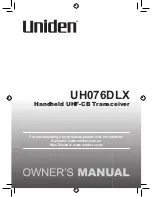
21
Radar horizon
Radar is essentially a “line-of-sight” phe-
nomenon. That means you have just about
the same range to horizon with a radar as
you do with your own eyes. However under
normal atmospheric conditions, the radar
horizon is 6% greater than the optical hori-
zon. Therefore, if the target does not rise
above the horizon the radar beam cannot be
reflected from the target.
The distance to the horizon from the scan-
ner, under normal conditions, is calculated
by the following formula.
Rmax = 2.2
x
h
1
+
h
2
Where Rmax: Radar horizon (mile), h1: An-
tenna height (meters), h2: Target height
(meters)
Figure 3-1 Radar horizon
3.2 Target Properties and
Radar Wave Reflection
Generally, larger targets can be seen on the
radar display at greater ranges, provided
line-of-sight exists between the scanner and
target. However, a large target with poor
reflecting properties may not be detected as
easily as a smaller target with better reflect-
ing properties. For example, you might ex-
pect a lighthouse to be a good radar target
because of its size. In actuality the return
echo is weak since the conical shape diffuses
most of the radiated energy.
A ship whose hull is made of conducting
materials, such as steel, will return a rela-
tively strong echo.
3. INTERPRETING
THE DISPLAY
As an aid to navigation, radar can be a very
valuable tool. No other electronic naviga-
tion aid can give you the ability to spot ves-
sels coming at you in the fog, or tell you the
location of the inlet to the harbor in the pitch
black of night.
To help you understand what your radar can
(and cannot) do for you this chapter covers
• the characteristics of the radar wave
• target properties and radar wave reflec-
tion
• range and bearing resolution, and
• false echoes.
3.1 The Radar Wave and
Radar Horizon
How the radar wave travels
The radar wave tends to travel in straight
lines at the speed of light. However, it is
subject to bending or refraction in the atmo-
sphere, the amount depending on region and
density.
Super-refraction
Super-refraction is a condition in which
there is an upper layer of warm dry air over
a surface layer of cold, moist air. Radar
waves bend downward and thus increase the
ranges at which targets may be detected.
Sub-refraction
Sub-refraction is the reverse condition of
super-refraction; a layer of cold air is above
a layer of warm air. Radar waves bend up-
ward and thus decrease the ranges at which
targets may be detected.
D
h
Horizon
Wave
path
h
1
2
















































